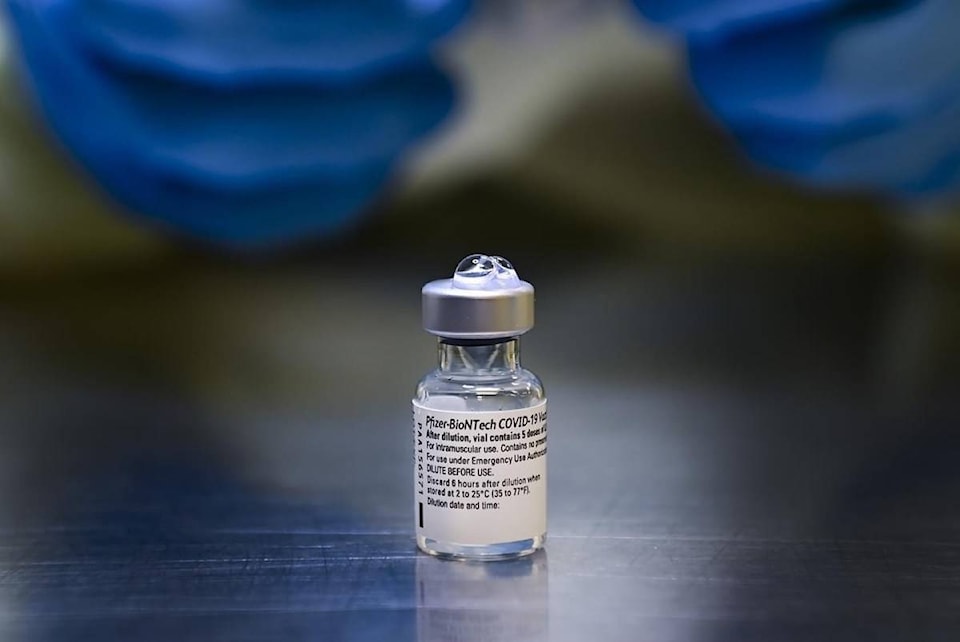British Columbia should change its COVID-19 vaccine rollout plans to prioritize essential workers who can’t avoid contact with others, suggests research from mathematical modelling experts at Simon Fraser University.
In a paper out Wednesday, which has yet to be peer-reviewed, the experts outline how their modelling shows vaccinating essential workers earlier could prevent more infections, hospitalizations and deaths than the province’s age-based approach.
The shift in strategy for vaccinating the general population could also save millions in health-care costs and reduce instances of so-called long COVID, or people who experience symptoms for more than 28 days, they say.
B.C. has decided to vaccinate older residents before younger people. The third phase of the campaign is set to start in April and last until June, covering people between the ages of 60 and 79, along with those who are highly clinically vulnerable, such as cancer patients.
The new modelling shows prioritizing workers in essential services including teaching, retail, food production and law enforcement could reduce the amount of virus circulating in communities and provide “a significant level of indirect protection for older adults,” the paper says.
Paul Tupper, a mathematics professor and co-author of the paper, said it might seem counterintuitive to shift away from prioritizing older people at greater risk of severe illness, but the best way to protect them is to keep the prevalence of COVID-19 down in the general population.
“A very effective way of doing that is vaccinating people that have lots of contacts as part of their job,” he said in an interview.
A key consideration is that although the vaccines approved in Canada so far are effective, five to 10 per cent of people who get both doses may not be protected, along with those who decline receiving the shot, Tupper said.
That means as many as 20 to 30 per cent of people targeted in the next phase of B.C.’s immunization campaign may not be protected from getting sick with COVID-19, he said, but it’s possible to prevent exposure by reducing transmission among people in greater contact with others.
The study concludes that vaccinating B.C.’s essential workers sooner could prevent up to 200,000 infections and 600 deaths, while saving about $230 million in health-care costs.
The researchers’ modelling relied on estimates of social contact among 15 age groups from infants to 79-year-olds in different settings, such as home, work and school, as well as survey data from the B.C. Centre for Disease Control to estimate the distribution of essential workers by age group.
They ran simulations for five scenarios in B.C.’s vaccine rollout, considering varying levels of vaccine efficacy when it comes to blocking transmission in addition to providing protection for the person who gets the shot.
The found an oldest-first strategy is only best to prevent deaths when the vaccines’ efficacy against transmission is “extremely low” and when the reproductive number for the virus is high, meaning on average each person infected leads to more than one additional case.
While B.C.’s case numbers have plateaued rather than declined in recent weeks, they’re not growing exponentially, said Tupper, and mounting evidence suggests the approved vaccines do prevent infection and block transmission rather than simply protect against symptomatic illness.
When asked for comment, the B.C. Health Ministry referred to an answer given at a news briefing on Tuesday by provincial health officer Dr. Bonnie Henry when she stuck by the plan to begin an age-based vaccination campaign in the spring, saying the approach has been “supported across the world.”
B.C. officials would consider changing the plan to include essential workers if enough doses of vaccine became available, she said.
Organizations representing teachers and dentists in B.C., as well as Metro Vancouver bus drivers, have said their members should be prioritized because of their contact with the public.
Kim Novak, president of United Food and Commercial Workers Local 1518, which represents grocery and retail workers, said Wednesday there’s been a recent uptick in cases among members. Anxiety has increased with the news that several faster-spreading variants have reached B.C., she added.
Novak said she agreed that the most vulnerable residents, and those who are most at risk of dying, need to be vaccinated first. But she said front-line workers must be prioritized if the province’s vaccine supply grows.
“In some cases, our members are interacting with hundreds of people a day and thousands of people a month, and so to reduce exposure and to reduce transmission, we feel strongly that there should be prioritization when more vaccines come available for front-line workers.”
The province reported 456 new cases of COVID-19 and two more deaths Wednesday, pushing the death toll from the illness in B.C. to 1,338.
There have been 230,875 doses of COVID-19 vaccine administered, including more than 62,000 second shots.
The first phase of B.C.’s immunization campaign focused on health-care workers in hospitals, paramedics, residents and staff at long-term care homes, and remote Indigenous communities.
